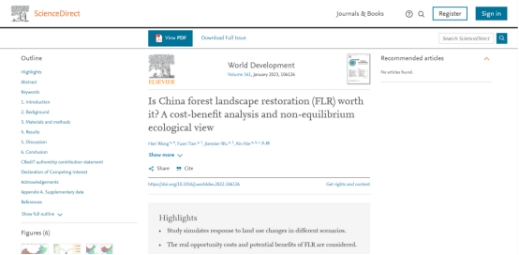
recently, a paper titled "is china forest landscape restoration (flr) worth it? a cost-benefit analysis and non-equilibrium ecological view" was published in world development, with professor han wang as the lead author.
as a crucial component of ecological restoration, restoration programs are widely used to address issues such as food shortages, land degradation, climate change, and biodiversity loss. they play an important role in achieving multiple restoration goals and have become a global policy objective. undoubtedly, implementing flr is beneficial from the perspective of ecological benefits. however, some critics argue that the investment is too high and the returns are minimal, making flr a poor investment. with the increasing importance of ecological conservation and sustainable development worldwide, it is imperative to conduct a more comprehensive and in-depth evaluation of flr. early studies on flr have sought to refine the cost-benefit analysis (cba) by using a broader economic value—ecosystem service value (ves) and its supply cost. however, most existing research has been conducted under the concept of equilibrium ecology, considering only partial and static ecosystem service values. this approach overlooks the potential significant benefits and actual opportunity costs of restoration programs, failing to accurately reflect the true net benefits of ecological restoration plans, thus affecting policymakers' ability to make scientifically sound decisions.
this paper adopts a non-equilibrium ecological perspective, combining land-use change models with economic analysis (ecosystem service value assessment) to conduct a comprehensive cost-benefit analysis of china's flr program. first, the land-use change model simulates changes in land use types in china from 2010 to 2030 under four different development scenarios. then, the equivalent factor method is used to quantify the response of ves to changes in land-use types, and public data is used to quantify the response of ces to changes in land-use types. subsequently, the net benefits of two development scenarios that include flr are compared with those of two scenarios that do not, to determine the true net benefits of china's forest landscape restoration.
the study simulates responses to land-use changes under different scenarios, taking into account the actual opportunity costs and potential benefits of flr. by integrating ecological and economic values, the study concludes that flr is worthwhile. the research contributes to supporting more quantifiable goals.
journal overview
world development is a top academic journal in the field of development studies, hosted by the united nations development programme. it is one of the most influential academic journals in development economics, ranked as a top journal in the economics field by the chinese academy of sciences.

